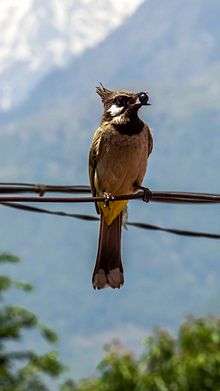Himalayan bulbul
| Himalayan bulbul | |
|---|---|
 | |
| Scientific classification | |
| Kingdom: | Animalia |
| Phylum: | Chordata |
| Class: | Aves |
| Order: | Passeriformes |
| Family: | Pycnonotidae |
| Genus: | Pycnonotus |
| Species: | P. leucogenys |
| Binomial name | |
| Pycnonotus leucogenys (Gray, 1835) | |
The Himalayan bulbul (Pycnonotus leucogenys) or White-cheeked Bulbul is a species of songbird in the Pycnonotidae family, native to central Asia.
Description
The Himalayan bulbul about 18 cm in length, with a wingspan of 25.5-28 cm and an average weight of 30 g. Its head, throat, and crest are black and white. The back side, and a lengthy tail are brown, the underside and pale yellow. Sexes have are alike. The song is a beautiful 4-piece whistle, which resembles an accelerated oriole whistle.
Distribution and habitat
The species occurs in the northern regions of the Indian subcontinent and some adjoining areas. It is found in Afghanistan, Bhutan, India, Nepal, Pakistan and Tajikistan.[1] It is the national bird of Bahrain.[2]
The Himalayan bulbul frequents forests and shrubland and also comes into gardens and parks.
Ecology
The Himalayan bulbul feeds on insects and other small invertebrates, as well as berries, fruits, seeds, buds and nectar.
Nests are usually built in bushes or low branches and cup-shaped, made of stems, roots and twigs. The female usually lays three eggs, which are incubated for 12 days. The chicks leave the nest when they are 9–11 days old. There may be up to three broods raised per year. During breeding, adults become very territorial.
Gallery
-

-

-

-

At the Shimla Water catchment, Himachal Pradesh
References
- 1 2 BirdLife International (2012). "Pycnonotus leucogenys". IUCN Red List of Threatened Species. Version 2013.2. International Union for Conservation of Nature. Retrieved 26 November 2013.
- ↑ http://www.davidandliz.com/birds.htm
